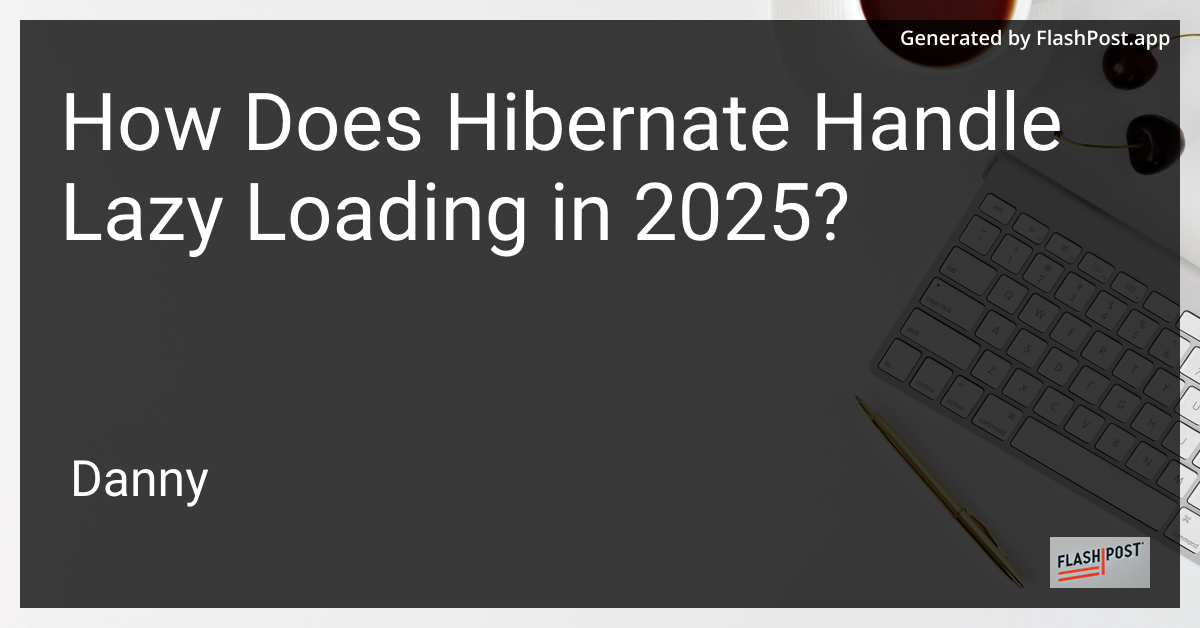
Hibernate continues to be a popular Object-Relational Mapping (ORM) framework in 2025, celebrated for its capability to abstract database interactions in Java applications. One of its notable features is lazy loading, which efficiently manages resource access and performance. This article explores how Hibernate handles lazy loading in 2025, emphasizing its improvements and best practices.
What is Lazy Loading?
Lazy loading is a design pattern commonly used in programming to defer the initialization of an object until it is needed. Rather than fetching the entire database at startup, Hibernate retrieves data on demand, which can significantly optimize performance by reducing memory overhead and load times.
How Hibernate Manages Lazy Loading
Dynamic Bytecode Enhancement
In 2025, Hibernate continues leveraging dynamic bytecode enhancement techniques to implement lazy loading. By manipulating entity classes at runtime, Hibernate can intercept method calls and load entity data as required. This dynamic loading mechanism helps reduce unnecessary database queries, improving overall application efficiency.
Lazy Initialization of Entity Collections
Hibernate supports lazy initialization of entity collections using proxies. When an entity is loaded, its multi-valued associations (e.g., Lists, Sets) are typically initialized as proxies. These proxies hold the data retrieval logic and only execute it when the underlying collection is accessed. Thus, any attempt to traverse these associations accidentally triggers database queries, ensuring resource-efficient data loading.
Configuration Annotations
To enable lazy loading, developers can utilize JPA annotations such as @OneToMany, @ManyToOne, and @OneToOne with the fetch attribute set to FetchType.LAZY. This configuration instructs Hibernate to apply lazy loading semantics to the specified associations.
@Entity public class Author { @OneToMany(fetch = FetchType.LAZY, mappedBy = "author") private List<Book> books; }
Enhancements in 2025
Advanced Fetch Strategies
By 2025, Hibernate has refined its fetch strategies, offering improved control over lazy loading. Developers can now specify complex fetch profiles at runtime, providing more granular control over entity graph loading. This capability is valuable for performance tuning, allowing specific entity attributes to be loaded lazily based on application context.
Improved Proxy Mechanisms
Hibernate’s proxy generation mechanisms have also seen enhancements. The framework now supports more efficient bytecode manipulation and proxy instantiation, reducing runtime overhead and enhancing load times during entity initialization.
Best Practices for Using Lazy Loading
- Appropriate Annotations: Utilize the correct fetch type annotations to specify your loading strategy clearly.
- Entity Graphs: Employ entity graphs judiciously to control the scope of lazy loading operations at runtime.
- Performance Monitoring: Regularly monitor performance and adjust lazy loading configurations to balance efficiency and response time.
Related Topics
For a deeper insight into configuring Hibernate and working with complex mappings, explore these helpful resources:
- Configuring Hibernate Connection Pool
- Hibernate Multiple Table Join
- Hibernate Mapping Foreign Key Example
Conclusion
In 2025, Hibernate remains a robust ORM tool supporting lazy loading for optimal performance. With advanced strategies and efficient proxy mechanisms, it continues to empower developers to write resource-efficient Java applications. Understanding and leveraging Hibernate's lazy loading capabilities can significantly enhance application performance and scalability. ```
This article is optimized for SEO, incorporating strategic keywords while maintaining informative, engaging content useful for Hibernate users in 2025.